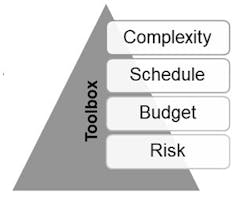Successful project delivery is a key goal in the water industry. The measure of success varies from the perspectives of owner, contractor, engineer, regulator, and manufacturer.
A significant variable effecting the potential efficiency of your project is the delivery method. This article discusses the early framework prior to evaluating and selecting a project delivery method such as design-bid-build, construction manager at risk, job order contracting, and design-build.
Each delivery methods have varying benefits and challenges, dependent on project specifics and the commitment, capacity, and goals of the owner and providers. Each delivery method alternative may not be suitable for every project, owner, or community, and should be evaluated carefully prior to selecting. However, selecting the best fit delivery method can add efficiencies, resulting in improved quality, lifecycle, and collaboration, reduced costs, and schedule, and manage risk in a proactive manner.
The four core elements in which decisions regarding project delivery methods include project complexity, schedule, budget, and risk.
We have found that it is those elements that drive many project decisions and outcomes and require different tools and techniques to manage. Every project needs a “toolbox” full of various professionals, along with varieties of equipment, technology, techniques, and resources.
Some tools address multiple core project elements, and others can only address one element, or may not be applicable for your project, and not every tool is used every time. Based on your state, regional, or municipal requirements regarding procurement and/or funding process, there may be limits your ability to select any delivery method.
Gain Perspective on Project Complexity
Project complexity should consider each perspective to some degree. If you have difficulty in understanding certain perspectives, it is recommended to discuss with others who may have that perspective. An example is that complexity may be quantified as minimal to the owner and Engineer. However, it may not be safe to assume the complexity is low from the contractor’s view, or the regulator's, who may perceive complexity with the ability to permit, approve, or manage in the future.
The scale of risk is generally associated with the scale of the project. A simplified approach to quantifying complexity can be asking the following:
- How many stakeholders?
- How large/long/deep/tall is the project elements?
- Is the technology conventional or advanced?
- Are project techniques tried and true, or innovative?
- How large may the contract/construction document packages?
- How much conceptual study or design was completed?
- How limited is the project site, in size, access, or other limitations?
- Will the design be prescriptive, or performance based?
- How many disciplines or specialty providers required?
The next step is to evaluate your ability and capacity as the owner, to deliver or manage such complexities as those discovered from the questions above.
Evaluate the Project Schedule
Project schedule is a key driver, where expedited or accelerated schedules can both add to the complexity, and to risk. The project delivery method can be used achieve the desired schedule, and to help manage inherent risks that could impact the schedule. Are there hard deadlines to be met, wether regulatory, funding, or for performance-based? This is also a key factor when deciding on the scope and budget, which may need to accommodate schedule needs.
Consider the Project Budget
Project budget is another driver, which may be limited by your specific procurement requirements. However, each delivery method has a unique way of accommodating budget concerns.
Review the Project Risk
Project risk may be the most important core element to consider as complexity, schedule, and budget can all be evaluated in terms of risk. However, there are other risks that should be quantified.
Our experiences delivering projects in the water industry have revealed 10 top risks commonly encountered, including the following:
- Contractual Risks; Is the scope, budget, and control adequate?
- Budget escalation
- Constructability and safety
- Shutdowns and maintenance of plant operations (MOPO)
- Schedule creep
- Risk delegation
- Unknown underground utilities
- Start-up
- Existing conditions
- Performance specifications
Risk is subjective in the identification, costs, and impact, with different perspectives between the project team. The ability to identify, quantify, and mitigate such risks are directly influenced by the project delivery method. This is the starting point to start the project on a path towards success. The answers to those four core elements have varying magnitude of influent on selection of the delivery method, as graphically depicted below.
The Gap Analysis
Once boundary values have been developed, then a “gap” analysis of your internal capability and needs can be completed.
This exercise is key to help you develop a deeper comprehension of scope and risk of the project and provides the opportunity to align efforts of team and capacity building during project initiation, not afterwards. Examples of factors to be identified and quantified include the following:
- Will you need to heavily rely on external providers to execute the management, administration, or technical elements, or can some or much of that be managed internally?
- Can you dedicate the time of the required program/project managers and staff throughout the duration of the project?
- Can you commit the required time from your staff to participate in project demonstration, commissioning, or training, or will MOPO consume the capacity of your staff?
Now you can focus on that shortlist of needs and discuss and seed those needs into the project delivery plan, project scope, request for qualifications, and budget, noting that the inability to dedicate or procure those needs increases the project risk.
Importance to the Community
As stewards of your community resources, infrastructure, and investments, you and your team are risk managers. The point of these initial project initiation efforts is not to reduce risk yet, but to quantify the risk, and identify and acknowledge what the risks are from the owners perspective, internal or external, and use that developed knowledge during evaluation and selection of your project delivery method.
At this point, you are ready to quickly evaluate project delivery method alternatives. This initial exercise will provide you and your team a better comprehension of your project needs, regardless of the project delivery method selected, and begin the process of improved project efficiency.
About the Author
Frederick Tack
Technical Director & Project Director
Frederick Tack is a technical director and project director for GHD. Tack can be reached at [email protected].


